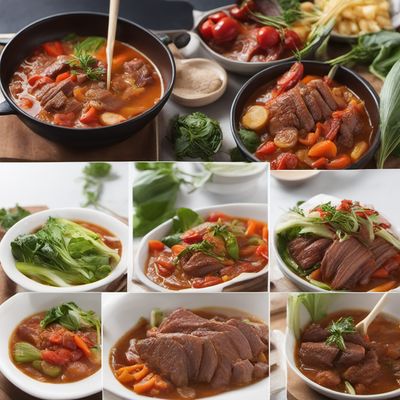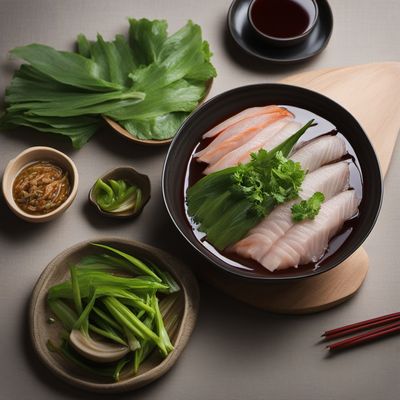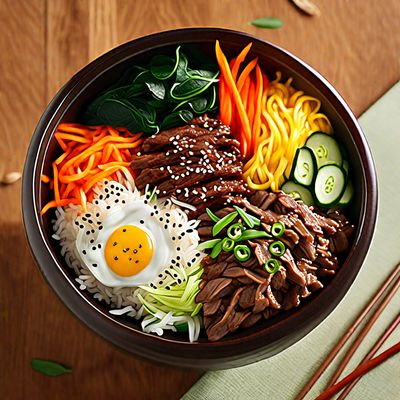
Ingredient
Pak-choi
The Leafy Wonder
Pak-choi is a leafy vegetable with thick, white stalks and dark green leaves. It has a mild and slightly sweet flavor, similar to cabbage or spinach. The stalks are crunchy, while the leaves are tender and delicate. Pak-choi is commonly used in Asian cuisines, particularly Chinese and Korean dishes.
Origins and history
Pak-choi has its roots in China, where it has been cultivated for over 6,000 years. It is a staple in Chinese cuisine and is often associated with traditional dishes such as stir-fries, hot pots, and dumplings. Over time, its popularity spread to other parts of Asia and eventually to the Western world.
Nutritional information
Pak-choi is low in calories and fat, making it a nutritious addition to meals. It is a good source of vitamins A, C, and K, as well as calcium and potassium. Its high water content also contributes to hydration and overall well-being.
Allergens
There are no known allergens associated with pak-choi.
How to select
When selecting pak-choi, look for firm stalks and vibrant green leaves. Avoid wilted or discolored leaves, as they indicate poor quality. The size of the vegetable does not necessarily indicate its quality, as both small and large pak-choi can be equally delicious.
Storage recommendations
To maintain the freshness of pak-choi, store it in the refrigerator. Wrap the vegetable in a damp paper towel and place it in a plastic bag or airtight container. It can stay fresh for up to one week. Avoid washing the vegetable until you are ready to use it, as excess moisture can cause it to spoil faster.
How to produce
Pak-choi can be easily grown in a home garden or in containers. It prefers cool weather and partial shade. Sow the seeds directly into the soil or start them indoors and transplant them once they have grown a few inches tall. With regular watering and proper care, you can harvest fresh pak-choi within a few weeks.
Preparation tips
To prepare pak-choi, start by separating the stalks from the leaves. Rinse them thoroughly under cold water to remove any dirt or debris. The stalks can be sliced or chopped, while the leaves can be left whole or torn into smaller pieces. Pak-choi can be stir-fried, steamed, boiled, or added raw to salads for a refreshing crunch.
Culinary uses
Pak-choi is commonly used in stir-fries, soups, and noodle dishes in Chinese cuisine. It can also be pickled, fermented, or used as a filling in dumplings. The tender leaves are often added to salads or used as a garnish for various dishes.
Availability
Pak-choi is widely available in Asian markets, supermarkets, and grocery stores around the world. It is commonly cultivated in China, Korea, Japan, and other Asian countries. It can also be found in local farmers markets during the growing season.
More ingredients from this category
Recipes using Pak-choi

Korean-Style Laksa
Kimchi Infused Spicy Noodle Soup

Pochero with a Twist
Savory Beef Stew with a Filipino Flair

Filipino-style Cozido
Hearty Filipino Cozido: A Fusion of Portuguese and Filipino Flavors

Korean-style Gulyás
Bulgogi Gulyás: A Fusion of Korean and Hungarian Flavors

Puerto Rican Chinese Cazuela
Savory Fusion: Puerto Rican Chinese Cazuela

Teochew-style Steamed Buri with Pickled Vegetables
Delicate Steamed Buri with Tangy Teochew Pickles

Pado'Lalo' with Coconut Milk and Fresh Herbs
Tropical Delight: Palauan Pado'Lalo' Infused with Creamy Coconut Milk

Kare-Kare with a Twist
Peanutty Delight: A Modern Twist on Filipino Kare-Kare

Homestyle Herbal Pork Soup
Savory Malaysian Herbal Pork Soup: A Comforting Delight

Bibimbap
The Ultimate Bibimbap: A Flavorful Korean Delight

Taiwanese-style Edikaikong Soup
Savory Green Delight: Taiwanese-style Edikaikong Soup
